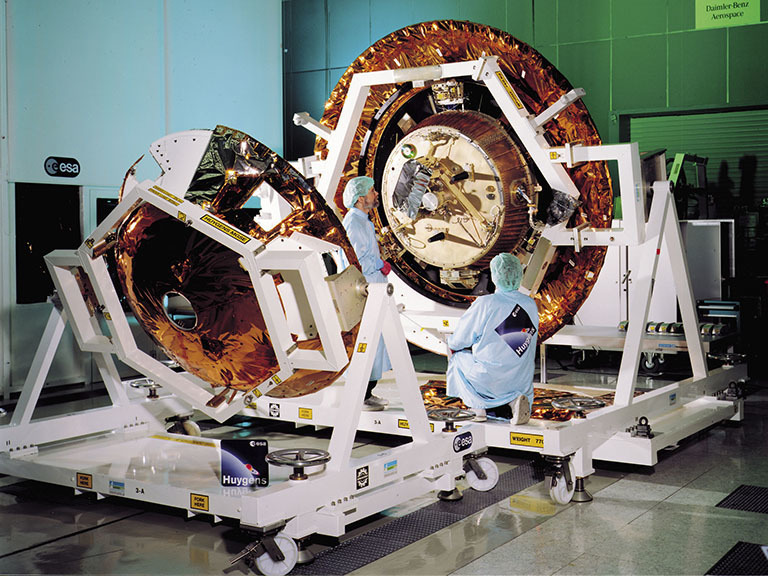Spacecraft

The Huygens probe nestled in its descent module. Image Credit and Copyright: European Space Agency
The European Space Agency's Huygens Probe was a unique, advanced spacecraft and a crucial part of the overall Cassini mission to explore Saturn. The probe was about 9 feet wide (2.7 meters) and weighed roughly 700 pounds (318 kilograms). It was built like a shellfish: a hard shell protected its delicate interior from high temperatures during the a two hour and 27 minute descent through the atmosphere of Saturn's giant moon Titan.
The probe had two parts: the Entry Assembly Module and the Descent Module. The Entry Assembly Module carried the equipment to control Huygens after separation from Cassini, and a heat shield that acted as a brake and as thermal protection. The Descent Module contained the scientific instruments and three different parachutes that were deployed in sequence to control Huygens' descent to the surface of Titan.
This probe landed on Titan on January 14, 2005. The Probe Support Equipment (PSE) remained attached to the orbiting spacecraft. The support equipment included the electronics necessary to track the probe, recover the data gathered during its descent and process and deliver the data to the orbiter. The data was then transmitted or downlinked from the orbiter to Earth. The Huygens probe payload also consisted of six scientific instruments, each designed to perform a different function as the probe descended through Titan's murky atmosphere:
-
Huygens Atmospheric Structure Instrument (HASI): This instrument contained a suite of sensors that measured the physical and electrical properties of Titan's atmosphere. Accelerometers measured forces in all three axes as the probe descended through the atmosphere. Since the aerodynamic properties of the probe were already known, it was possible to determine the density of Titan's atmosphere and detect wind gusts. Had the probe landed on a liquid surface, this instrument would have been able to measure the probe motion due to waves. Temperature and pressure sensors also measured the thermal properties of the atmosphere. The Permittivity and Electromagnetic Wave Analyzer component measured the electron and ion (i.e., positively charged particle) conductivities of the atmosphere and searched for electromagnetic wave activity. On the surface of Titan, the conductivity and permittivity (i.e., the ratio of electric flux density produced to the strength of the electric field producing the flux) of the surface material was measured.
-
Doppler Wind Experiment (DWE): The intent of this experiment was to measure the wind speed during Huygens' descent through Titan's atmosphere by observing changes in the carrier frequency of the probe due to the Doppler effect. This measurement could not be done from space because of a configuration problem with one of Cassini's receivers. However, scientists were able to measure the speed of these winds using a global network of radio telescopes.
-
Descent Imager/Spectral Radiometer (DISR):
This instrument made a range of imaging and spectral observations using several sensors and fields of view. By measuring the upward and downward flow of radiation, the radiation balance (or imbalance) of the thick Titan atmosphere was measured. Solar sensors measured the light intensity around the Sun due to scattering by aerosols in the atmosphere. This permitted the calculation of the size and number density of the suspended particles. Two imagers (one visible, one infrared) observed the surface during the latter stages of the descent and, as the probe slowly rotated, built up a mosaic of pictures around the landing site. There was also a side-view visible imager that obtained a horizontal view of the horizon and the underside of the cloud deck. For spectral measurements of the surface, a lamp switched on shortly before landing that augmented the weak sunlight.
- Gas Chromatograph Mass Spectrometer (GCMS): This instrument was a versatile gas chemical analyzer that identified and measured chemicals in Titan's atmosphere. It was equipped with samplers that were filled at high altitude for analysis. The mass spectrometer built a model of the molecular masses of each gas, and a more powerful separation of molecular and isotopic species was accomplished by the gas chromatograph. During descent, the GCMS analyzed pyrolysis products (i.e., samples altered by heating) passed to it from the Aerosol Collector Pyrolyser. Finally, the GCMS measured the composition of Titan's surface in the event of a safe landing. This investigation was made possible by heating the GCMS instrument just prior to impact in order to vaporize the surface material upon contact.
- Aerosol Collector and Pyrolyser (ACP): This experiment drew in aerosol particles from the atmosphere through filters, then heated the trapped samples in ovens (the process of pyrolysis) to vaporize volatiles and decompose the complex organic materials. The products were then flushed along a pipe to the GCMS instrument for analysis. Two filters were provided to collect samples at different altitudes.
- Surface-Science Package (SSP): The Surface-Science Package contained a number of sensors designed to determine the physical properties of Titan's surface at the point of impact. These sensors also determined whether the surface was solid or liquid. An acoustic sounder, activated during the last 100 meters (328 feet) of the descent, continuously determined the distance to the surface, measuring the rate of descent and the surface roughness (e.g., due to waves). During descent, measurements of the speed of sound provided information on atmospheric composition and temperature, and an accelerometer accurately recorded the deceleration profile at impact, providing information on the hardness and structure of the surface. A tilt sensor measured any pendulum motion during the descent and indicated the probe attitude after landing


